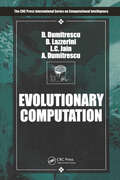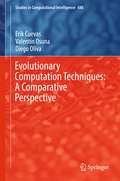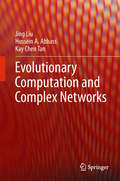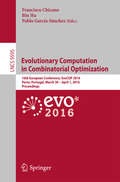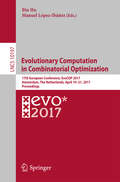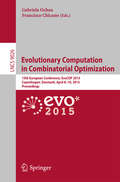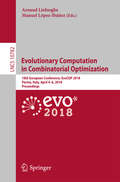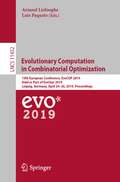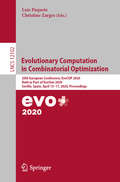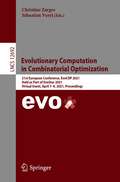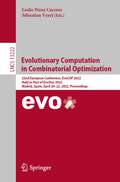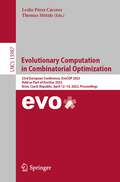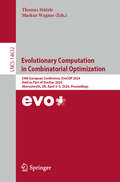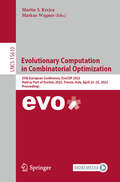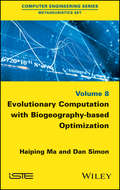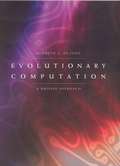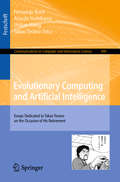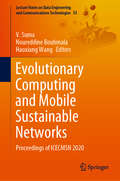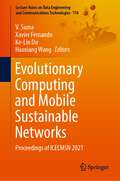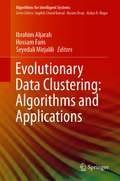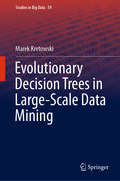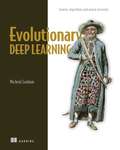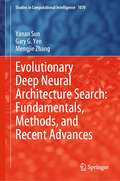- Table View
- List View
Evolutionary Computation (International Series on Computational Intelligence)
by D. Dumitrescu Beatrice Lazzerini Lakhmi C. Jain A. DumitrescuRapid advances in evolutionary computation have opened up a world of applications-a world rapidly growing and evolving. Decision making, neural networks, pattern recognition, complex optimization/search tasks, scheduling, control, automated programming, and cellular automata applications all rely on evolutionary computation. Evolutionary Com
Evolutionary Computation 1: Basic Algorithms and Operators (Ieee Press Series On Computational Intelligence Ser. #1)
by Thomas Baeck D. B Fogel Z MichalewiczThe field of evolutionary computation is expanding dramatically, fueled by the vast investment that reflects the value of applying its techniques. Culling material from the Handbook of Evolutionary Computation, Evolutionary Computation 1: Basic Algorithms and Operators contains up-to-date information on algorithms and operators used in evolutionary computing. This volume discusses the basic ideas that underlie the main paradigms of evolutionary algorithms, evolution strategies, evolutionary programming, and genetic programming. It is intended to be used by individual researchers, teachers, and students working and studying in this expanding field.
Evolutionary Computation Techniques: A Comparative Perspective
by Erik Cuevas Diego Oliva Valentín OsunaThis book compares the performance of various evolutionary computation (EC) techniques when they are faced with complex optimization problems extracted from different engineering domains. Particularly focusing on recently developed algorithms, it is designed so that each chapter can be read independently. Several comparisons among EC techniques have been reported in the literature, however, they all suffer from one limitation: their conclusions are based on the performance of popular evolutionary approaches over a set of synthetic functions with exact solutions and well-known behaviors, without considering the application context or including recent developments. In each chapter, a complex engineering optimization problem is posed, and then a particular EC technique is presented as the best choice, according to its search characteristics. Lastly, a set of experiments is conducted in order to compare its performance to other popular EC methods.
Evolutionary Computation and Complex Networks
by Hussein A. Abbass Jing Liu Kay Chen TanThis book introduces the linkage between evolutionary computation and complex networks and the advantages of cross-fertilising ideas from both fields. Instead of introducing each field individually, the authors focus on the research that sits at the interface of both fields. The book is structured to address two questions: (1) how complex networks are used to analyze and improve the performance of evolutionary computation methods? (2) how evolutionary computation methods are used to solve problems in complex networks? The authors interweave complex networks and evolutionary computing, using evolutionary computation to discover community structure, while also using network analysis techniques to analyze the performance of evolutionary algorithms. The book is suitable for both beginners and senior researchers in the fields of evolutionary computation and complex networks.
Evolutionary Computation in Combinatorial Optimization
by Bin Hu Francisco Chicano Pablo García-SánchezThisbook constitutes the refereed proceedings of the 16th European Conference onEvolutionary Computation in Combinatorial Optimization, EvoCOP 2016, held in Porto,Portugal, in March/April 2016, co-located with the Evo*2015 events EuroGP,EvoMUSART and EvoApplications. The17 revised full papers presented were carefully reviewed and selected from 44submissions. The papers cover methodology, applications and theoretical studies. Themethods included evolutionary and memetic algorithms, variable neighborhoodsearch, particle swarm optimization, hyperheuristics, mat-heuristic and otheradaptive approaches. Applications included both traditional domains, such asgraph coloring, vehicle routing, the longest common subsequence problem, thequadratic assignment problem; and new(er) domains such as the traveling thiefproblem, web service location, and finding short addition chains. Thetheoretical studies involved fitness landscape analysis, local search and recombinationoperator analysis, and the big valley search space hypothesis. Theconsideration of multiple objectives, dynamic and noisy environments was alsopresent in a number of articles.
Evolutionary Computation in Combinatorial Optimization
by Bin Hu Manuel López-IbáñezThis book constitutes the refereed proceedings of the 16th European Conference on Evolutionary Computation in Combinatorial Optimization, EvoCOP 2016, held in Porto, Portugal, in March/April 2016, co-located with the Evo*2015 events EuroGP, EvoMUSART and EvoApplications. The 17 revised full papers presented were carefully reviewed and selected from 44 submissions. The papers cover methodology, applications and theoretical studies. The methods included evolutionary and memetic algorithms, variable neighborhood search, particle swarm optimization, hyperheuristics, mat-heuristic and other adaptive approaches. Applications included both traditional domains, such as graph coloring, vehicle routing, the longest common subsequence problem, the quadratic assignment problem; and new(er) domains such as the traveling thief problem, web service location, and finding short addition chains. The theoretical studies involved fitness landscape analysis, local search and recombination operator analysis, and the big valley search space hypothesis. The consideration of multiple objectives, dynamic and noisy environments was also present in a number of articles.
Evolutionary Computation in Combinatorial Optimization
by Francisco Chicano Gabriela OchoaThis book constitutes the refereed proceedings of the 15th European Conference on Evolutionary Computation in Combinatorial Optimization, EvoCOP 2015, held in Copenhagen, Denmark, in April 2015, co-located with the Evo*2015 events EuroGP, EvoMUSART and EvoApplications. The 19 revised full papers presented were carefully reviewed and selected from 46 submissions. The papers cover methodology, applications and theoretical studies. The methods included evolutionary and memetic (hybrid) algorithms, iterated local search, variable neighbourhood search, ant colony optimization, artificial immune systems, hyper-heuristics and other adaptive approaches. The applications include both traditional domains, such as graph coloring, knapsack, vehicle routing, job-shop scheduling, the p-median and the orienteering problems; and new(er) domains such as designing deep recurrent neural networks, detecting network community structure, lock scheduling of ships, cloud resource management, the fire-fighter problem and AI planning. The theoretical studies involved approximation ratio, runtime and black-box complexity analyses.
Evolutionary Computation in Combinatorial Optimization: 18th European Conference, EvoCOP 2018, Parma, Italy, April 4–6, 2018, Proceedings (Lecture Notes in Computer Science #10782)
by Manuel López-Ibáñez Arnaud LiefoogheThis book constitutes the refereed proceedings of the 18th European Conference on Evolutionary Computation in Combinatorial Optimization, EvoCOP 2018, held in Parma, Italy, in April 2018, co-located with the Evo* 2018 events EuroGP, EvoMUSART and EvoApplications. The 12 revised full papers presented were carefully reviewed and selected from 37 submissions. The papers cover a wide spectrum of topics, ranging from the foundations of evolutionary computation algorithms and other search heuristics, to their accurate design and application to both single- and multi-objective combinatorial optimization problems. Fundamental and methodological aspects deal with runtime analysis, the structural properties of fitness landscapes, the study of metaheuristics core components, the clever design of their search principles, and their careful selection and configuration by means of automatic algorithm configuration and hyper-heuristics. Applications cover conventional academic domains such as NK landscapes, binary quadratic programming, traveling salesman, vehicle routing, or scheduling problems, and also include real-world domains in clustering, commercial districting and winner determination.
Evolutionary Computation in Combinatorial Optimization: 19th European Conference, EvoCOP 2019, Held as Part of EvoStar 2019, Leipzig, Germany, April 24–26, 2019, Proceedings (Lecture Notes in Computer Science #11452)
by Arnaud Liefooghe Luís PaqueteThis book constitutes the refereed proceedings of the 19th European Conference on Evolutionary Computation in Combinatorial Optimization, EvoCOP 2019, held as part of Evo* 2019, in Leipzig, Germany, in April 2019, co-located with the Evo* 2019 events EuroGP, EvoMUSART and EvoApplications.The 14 revised full papers presented were carefully reviewed and selected from 37 submissions. The papers cover a wide spectrum of topics, ranging from the foundations of evolutionary computation algorithms and other search heuristics to their accurate design and application to both single- and multi-objective combinatorial optimization problems. Fundamental and methodological aspects deal with runtime analysis, the structural properties of fitness landscapes, the study of metaheuristics core components, the clever design of their search principles, and their careful selection and configuration. Applications cover domains such as scheduling, routing, partitioning and general graph problems.
Evolutionary Computation in Combinatorial Optimization: 20th European Conference, EvoCOP 2020, Held as Part of EvoStar 2020, Seville, Spain, April 15–17, 2020, Proceedings (Lecture Notes in Computer Science #12102)
by Luís Paquete Christine ZargesThis book constitutes the refereed proceedings of the 20th European Conference on Evolutionary Computation in Combinatorial Optimization, EvoCOP 2020, held as part of Evo*2020, in Seville, Spain, in April 2020, co-located with the Evo*2020 events EuroGP, EvoMUSART and EvoApplications.The 14 full papers presented in this book were carefully reviewed and selected from 37 submissions. The papers cover a wide spectrum of topics, ranging from the foundations of evolutionary computation algorithms and other search heuristics, to their accurate design and application to combinatorial optimization problems.
Evolutionary Computation in Combinatorial Optimization: 21st European Conference, EvoCOP 2021, Held as Part of EvoStar 2021, Virtual Event, April 7–9, 2021, Proceedings (Lecture Notes in Computer Science #12692)
by Christine Zarges Sébastien VerelThis book constitutes the refereed proceedings of the 21st European Conference on Evolutionary Computation in Combinatorial Optimization, EvoCOP 2021, held as part of Evo*2021, as Virtual Event, in April 2021, co-located with the Evo*2021 events: EvoMUSART, EvoApplications, and EuroGP. The 14 revised full papers presented in this book were carefully reviewed and selected from 42 submissions. They cover a wide spectrum of topics, ranging from the foundations of evolutionary algorithms and other search heuristics to their accurate design and application to combinatorial optimization problems. Fundamental and methodological aspects deal with runtime analysis, the structural properties of fitness landscapes, the study of core components of metaheuristics, the clever design of their search principles, and their careful selection and configuration. Applications cover problem domains such as scheduling, routing, search-based software engineering and general graph problems. The range of topics covered in this volume reflects the current state of research in the fields of evolutionary computation and combinatorial optimization.
Evolutionary Computation in Combinatorial Optimization: 22nd European Conference, EvoCOP 2022, Held as Part of EvoStar 2022, Madrid, Spain, April 20–22, 2022, Proceedings (Lecture Notes in Computer Science #13222)
by Sébastien Verel Leslie Pérez CáceresThis book constitutes the refereed proceedings of the 22nd European Conference on Evolutionary Computation in Combinatorial Optimization, EvoCOP 2022, held as part of Evo*2022, in Madrid, Spain, during April 20-21, 2022, co-located with the Evo*2022 events: EvoMUSART, EvoApplications, and EuroGP.The 13 revised full papers presented in this book were carefully reviewed and selected from 28 submissions. They present recent theoretical and experimental advances in combinatorial optimization, evolutionary algorithms, and related research fields.
Evolutionary Computation in Combinatorial Optimization: 23rd European Conference, EvoCOP 2023, Held as Part of EvoStar 2023, Brno, Czech Republic, April 12–14, 2023, Proceedings (Lecture Notes in Computer Science #13987)
by Thomas Stützle Leslie Pérez CáceresThis book constitutes the refereed proceedings of the 23rd European Conference on Evolutionary Computation in Combinatorial Optimization, EvoCOP 2023, held as part of Evo*2023, in Brno, Czech Republic in April 2023, co-located with the Evo*2023 events: EvoMUSART, EvoApplications, and EuroGP.The 15 revised full papers presented in this book were carefully reviewed and selected from 32 submissions. They present recent theoretical and experimental advances in combinatorial optimization, evolutionary algorithms, and related research fields.
Evolutionary Computation in Combinatorial Optimization: 24th European Conference, EvoCOP 2024, Held as Part of EvoStar 2024, Aberystwyth, UK, April 3–5, 2024, Proceedings (Lecture Notes in Computer Science #14632)
by Thomas Stützle Markus WagnerThis book constitutes the referred proceedings of the 24th European Conference on Evolutionary Computation in Combinatorial Optimization, EvoCOP 2024, held as part of EvoStar 2024, in Aberystwyth, UK, during April 3–5, 2024. The 12 full papers presented in this book were carefully reviewed and selected from 28 submissions. They cover a variety of topics, ranging from constructive algorithms, machine learning techniques ranging from neural network based guidance to sparse surrogate models for optimization problems, the foundation of evolutionary computation algorithms and other search heuristics, to multi-objective optimization problems.
Evolutionary Computation in Combinatorial Optimization: 25th European Conference, EvoCOP 2025, Held as Part of EvoStar 2025, Trieste, Italy, April 23–25, 2025, Proceedings (Lecture Notes in Computer Science #15610)
by Markus Wagner Martin S. KrejcaThis book constitutes the referred proceedings of the 25th European Conference on Evolutionary Computation in Combinatorial Optimization, EvoCOP 2025, held as part of EvoStar 2025, in Trieste, Italy, during April 23–25, 2025.The 16 full papers presented in this book were carefully reviewed and selected from 43 submissions. These papers cover a variety of topics, ranging from benchmark creation, over genetic programming, heuristics for real-world and NP-hard problems, as well as the foundations of evolutionary computation algorithms and other search heuristics, to both mixed-binary and multi-objective optimization.
Evolutionary Computation in Gene Regulatory Network Research
by Nasimul Noman Hitoshi IbaIntroducing a handbook for gene regulatory network research using evolutionary computation, with applications for computer scientists, computational and system biologists This book is a step-by-step guideline for research in gene regulatory networks (GRN) using evolutionary computation (EC). The book is organized into four parts that deliver materials in a way equally attractive for a reader with training in computation or biology. Each of these sections, authored by well-known researchers and experienced practitioners, provides the relevant materials for the interested readers. The first part of this book contains an introductory background to the field. The second part presents the EC approaches for analysis and reconstruction of GRN from gene expression data. The third part of this book covers the contemporary advancements in the automatic construction of gene regulatory and reaction networks and gives direction and guidelines for future research. Finally, the last part of this book focuses on applications of GRNs with EC in other fields, such as design, engineering and robotics. * Provides a reference for current and future research in gene regulatory networks (GRN) using evolutionary computation (EC) * Covers sub-domains of GRN research using EC, such as expression profile analysis, reverse engineering, GRN evolution, applications * Contains useful contents for courses in gene regulatory networks, systems biology, computational biology, and synthetic biology * Delivers state-of-the-art research in genetic algorithms, genetic programming, and swarm intelligence Evolutionary Computation in Gene Regulatory Network Research is a reference for researchers and professionals in computer science, systems biology, and bioinformatics, as well as upper undergraduate, graduate, and postgraduate students. Hitoshi Iba is a Professor in the Department of Information and Communication Engineering, Graduate School of Information Science and Technology, at the University of Tokyo, Toyko, Japan. He is an Associate Editor of the IEEE Transactions on Evolutionary Computation and the journal of Genetic Programming and Evolvable Machines. Nasimul Noman is a lecturer in the School of Electrical Engineering and Computer Science at the University of Newcastle, NSW, Australia. From 2002 to 2012 he was a faculty member at the University of Dhaka, Bangladesh. Noman is an Editor of the BioMed Research International journal. His research interests include computational biology, synthetic biology, and bioinformatics.
Evolutionary Computation with Biogeography-based Optimization
by Dan Simon Haiping MaEvolutionary computation algorithms are employed to minimize functions with large number of variables. Biogeography-based optimization (BBO) is an optimization algorithm that is based on the science of biogeography, which researches the migration patterns of species. These migration paradigms provide the main logic behind BBO. Due to the cross-disciplinary nature of the optimization problems, there is a need to develop multiple approaches to tackle them and to study the theoretical reasoning behind their performance. This manuscript intends to explain the mathematical model of BBO algorithm and its variants created to cope with continuous domain problems (with and without constraints) and combinatorial problems. Due to the cross-disciplinary nature of the optimization problems, there is a need to develop multiple approaches to tackle them and to study the theoretical reasoning behind their performance. This manuscript intends to explain the mathematical model of BBO algorithm and its variants created to cope with continuous domain problems (with and without constraints) and combinatorial problems.
Evolutionary Computation: A Unified Approach
by Kenneth A. de JongChoice Outstanding Academic Title, 2006. Evolutionary computation, the use of evolutionary systems as computational processes for solving complex problems, is a tool used by computer scientists and engineers who want to harness the power of evolution to build useful new artifacts, by biologists interested in developing and testing better models of natural evolutionary systems, and by artificial life scientists for designing and implementing new artificial evolutionary worlds. In this clear and comprehensive introduction to the field, Kenneth De Jong presents an integrated view of the state of the art in evolutionary computation. Although other books have described such particular areas of the field as genetic algorithms, genetic programming, evolution strategies, and evolutionary programming, Evolutionary Computation is noteworthy for considering these systems as specific instances of a more general class of evolutionary algorithms. This useful overview of a fragmented field is suitable for classroom use or as a reference for computer scientists and engineers.
Evolutionary Computing and Artificial Intelligence: Essays Dedicated to Takao Terano on the Occasion of His Retirement (Communications in Computer and Information Science #999)
by Fernando Koch Takao Terano Atsushi Yoshikawa Shihan WangThis Festschrift volume is published in honor of Takao Terano on the occasion of his retirement. Takao Terano is a leading expert in the areas of agent-based modelling, knowledge systems, evolutionary computation, and service science.The contributions in this volume reflect the breadth and impact of his work. The volume contains 12 full papers related to Takao Terano’s research. They deal with various aspects of artificial intelligence, multi-agent systems, collaborative and social computing, social networks, ubiquitous computing.
Evolutionary Computing and Mobile Sustainable Networks: Proceedings of ICECMSN 2020 (Lecture Notes on Data Engineering and Communications Technologies #53)
by Haoxiang Wang V. Suma Noureddine BouhmalaThis book features selected research papers presented at the International Conference on Evolutionary Computing and Mobile Sustainable Networks (ICECMSN 2020), held at the Sir M. Visvesvaraya Institute of Technology on 20–21 February 2020. Discussing advances in evolutionary computing technologies, including swarm intelligence algorithms and other evolutionary algorithm paradigms which are emerging as widely accepted descriptors for mobile sustainable networks virtualization, optimization and automation, this book is a valuable resource for researchers in the field of evolutionary computing and mobile sustainable networks.
Evolutionary Computing and Mobile Sustainable Networks: Proceedings of ICECMSN 2021 (Lecture Notes on Data Engineering and Communications Technologies #116)
by Ke-Lin Du Xavier Fernando Haoxiang Wang V. SumaThis book mainly reflects the recent research works in evolutionary computation technologies and mobile sustainable networks with a specific focus on computational intelligence and communication technologies that widely ranges from theoretical foundations to practical applications in enhancing the sustainability of mobile networks. Today, network sustainability has become a significant research domain in both academia and industries present across the globe. Also, the network sustainability paradigm has generated a solution for existing optimization challenges in mobile communication networks. Recently, the research advances in evolutionary computing technologies including swarm intelligence algorithms and other evolutionary algorithm paradigms are considered as the widely accepted descriptors for mobile sustainable networks virtualization, optimization, and automation. To deal with the emerging impacts on mobile communication networks, this book discusses about the state-of-the research works on developing a sustainable design and their implementation in mobile networks. With the advent of evolutionary computation algorithms, this book contributes varied research chapters to develop a new perspective on mobile sustainable networks.
Evolutionary Data Clustering: Algorithms and Applications (Algorithms for Intelligent Systems)
by Seyedali Mirjalili Hossam Faris Ibrahim AljarahThis book provides an in-depth analysis of the current evolutionary clustering techniques. It discusses the most highly regarded methods for data clustering. The book provides literature reviews about single objective and multi-objective evolutionary clustering algorithms. In addition, the book provides a comprehensive review of the fitness functions and evaluation measures that are used in most of evolutionary clustering algorithms. Furthermore, it provides a conceptual analysis including definition, validation and quality measures, applications, and implementations for data clustering using classical and modern nature-inspired techniques. It features a range of proven and recent nature-inspired algorithms used to data clustering, including particle swarm optimization, ant colony optimization, grey wolf optimizer, salp swarm algorithm, multi-verse optimizer, Harris hawks optimization, beta-hill climbing optimization. The book also covers applications of evolutionary data clustering in diverse fields such as image segmentation, medical applications, and pavement infrastructure asset management.
Evolutionary Decision Trees in Large-Scale Data Mining (Studies in Big Data #59)
by Marek KretowskiThis book presents a unified framework, based on specialized evolutionary algorithms, for the global induction of various types of classification and regression trees from data. The resulting univariate or oblique trees are significantly smaller than those produced by standard top-down methods, an aspect that is critical for the interpretation of mined patterns by domain analysts. The approach presented here is extremely flexible and can easily be adapted to specific data mining applications, e.g. cost-sensitive model trees for financial data or multi-test trees for gene expression data. The global induction can be efficiently applied to large-scale data without the need for extraordinary resources. With a simple GPU-based acceleration, datasets composed of millions of instances can be mined in minutes. In the event that the size of the datasets makes the fastest memory computing impossible, the Spark-based implementation on computer clusters, which offers impressive fault tolerance and scalability potential, can be applied.
Evolutionary Deep Learning: Genetic algorithms and neural networks
by Micheal LanhamDiscover one-of-a-kind AI strategies never before seen outside of academic papers! Learn how the principles of evolutionary computation overcome deep learning&’s common pitfalls and deliver adaptable model upgrades without constant manual adjustment.In Evolutionary Deep Learning you will learn how to: Solve complex design and analysis problems with evolutionary computation Tune deep learning hyperparameters with evolutionary computation (EC), genetic algorithms, and particle swarm optimization Use unsupervised learning with a deep learning autoencoder to regenerate sample data Understand the basics of reinforcement learning and the Q-Learning equation Apply Q-Learning to deep learning to produce deep reinforcement learning Optimize the loss function and network architecture of unsupervised autoencoders Make an evolutionary agent that can play an OpenAI Gym game Evolutionary Deep Learning is a guide to improving your deep learning models with AutoML enhancements based on the principles of biological evolution. This exciting new approach utilizes lesser-known AI approaches to boost performance without hours of data annotation or model hyperparameter tuning. In this one-of-a-kind guide, you&’ll discover tools for optimizing everything from data collection to your network architecture. About the technology Deep learning meets evolutionary biology in this incredible book. Explore how biology-inspired algorithms and intuitions amplify the power of neural networks to solve tricky search, optimization, and control problems. Relevant, practical, and extremely interesting examples demonstrate how ancient lessons from the natural world are shaping the cutting edge of data science. About the book Evolutionary Deep Learning introduces evolutionary computation (EC) and gives you a toolbox of techniques you can apply throughout the deep learning pipeline. Discover genetic algorithms and EC approaches to network topology, generative modeling, reinforcement learning, and more! Interactive Colab notebooks give you an opportunity to experiment as you explore. What's inside Solve complex design and analysis problems with evolutionary computation Tune deep learning hyperparameters Apply Q-Learning to deep learning to produce deep reinforcement learning Optimize the loss function and network architecture of unsupervised autoencoders Make an evolutionary agent that can play an OpenAI Gym game About the reader For data scientists who know Python. About the author Micheal Lanham is a proven software and tech innovator with over 20 years of experience. Table of Contents PART 1 - GETTING STARTED 1 Introducing evolutionary deep learning 2 Introducing evolutionary computation 3 Introducing genetic algorithms with DEAP 4 More evolutionary computation with DEAP PART 2 - OPTIMIZING DEEP LEARNING 5 Automating hyperparameter optimization 6 Neuroevolution optimization 7 Evolutionary convolutional neural networks PART 3 - ADVANCED APPLICATIONS 8 Evolving autoencoders 9 Generative deep learning and evolution 10 NEAT: NeuroEvolution of Augmenting Topologies 11 Evolutionary learning with NEAT 12 Evolutionary machine learning and beyond
Evolutionary Deep Neural Architecture Search: Fundamentals, Methods, and Recent Advances (Studies in Computational Intelligence #1070)
by Yanan Sun Gary G. Yen Mengjie ZhangThis book systematically narrates the fundamentals, methods, and recent advances of evolutionary deep neural architecture search chapter by chapter. This will provide the target readers with sufficient details learning from scratch. In particular, the method parts are devoted to the architecture search of unsupervised and supervised deep neural networks. The people, who would like to use deep neural networks but have no/limited expertise in manually designing the optimal deep architectures, will be the main audience. This may include the researchers who focus on developing novel evolutionary deep architecture search methods for general tasks, the students who would like to study the knowledge related to evolutionary deep neural architecture search and perform related research in the future, and the practitioners from the fields of computer vision, natural language processing, and others where the deep neural networks have been successfully and largely used in their respective fields.
